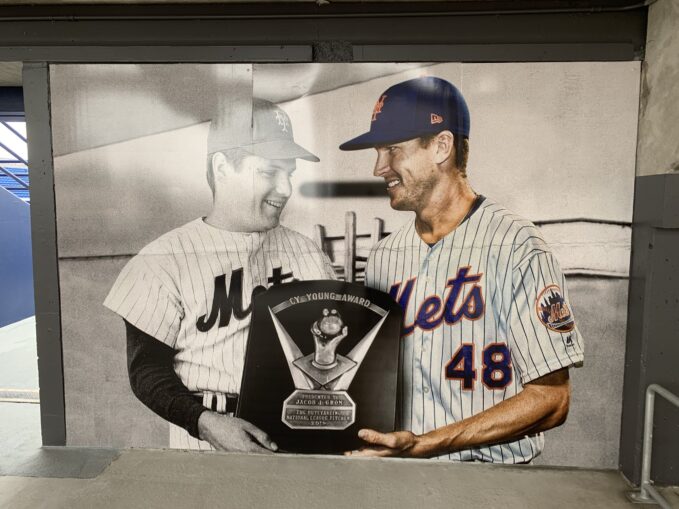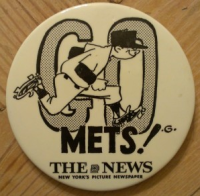
Photo by Tim Healey, Newsday
When Sandy Alderson’s front office was busy rebuilding the New York Mets at the start of the last decade, the focus seemed pretty simple: find as many elite starting pitchers as possible. Upon finding those arms, help them develop into top-tier MLB hurlers at around the same time-ish so they can all man the rotation together while in Queens.
Simple enough, until baseball is gonna baseball. The plan was looking quite good leading up into and during the 2015 season, though.
Matt Harvey made a splash in the big leagues before going down and coming back from Tommy John surgery. Zack Wheeler showed flashes of what he was capable of prior to succumbing to the same ailment (he technically isn’t homegrown but he’s close enough). Jacob deGrom went from filling in for Rafael Montero to the 2014 National League Rookie of the Year. Noah Syndergaard and Steven Matz rounded things out upon making their respective debuts in 2015 and having an immediate impact.
We already know this collective group didn’t accomplish what we as fans were hoping to see, and mostly because they didn’t get that much time to simply be in the rotation all at once. In the un-ending boredom of life without baseball, I was looking at FanGraphs’ Mets leaderboards for starting pitchers and noticed that a lot of recent names have found their way onto the front page.
In dissecting this list a bit, I decided to set the qualifying parameter to having at least 300 innings pitched as a starter for the Mets, leaving us with a group of 55 hurlers to look over. Only 18 have tossed at least 800 innings, with 13 eclipsing 1,000 frames. Among the five recent or current Mets pitchers mentioned above, only deGrom is part of that group thanks to the 1101.2 dominant innings he’s put together thus far in his career.
Despite that, four of the five (all but Matz) have accumulated enough fWAR on an individual basis to be ranked within the top 20 starting pitchers in team history. If the focus shifts to strikeout rate, all five are within the top 10. And if we want to shift the barometer to ERA, four (again, Matz not included) are among the top 30.
Considering the fact that deGrom has basically been the only one to have a straight upward trajectory during his career in Queens, this seems impressive. At least, it was to me.

Even though the final years of his career in New York didn’t include many good memories — on or off the mound — Harvey still managed to accumulate 13.4 fWAR. That currently has him 12th on the Mets’ all-time list and right behind Johan Santana (13.9) with a similar number of innings pitched. Wheeler’s Mets career is all but likely over at this point, but his dominant run from the past two years puts his career fWAR at 12.6, which is 17th-best in franchise history.
Syndergaard won’t be throwing a pitch in 2020 thanks to his own Tommy John surgery, but even if he never threw another pitch while donning the orange and blue again, his 18.7 fWAR has him comfortably among the organization’s top-10 pitchers. If the right-hander comes back in 2021 and replicates (or comes close to replicating) his 6.0-fWAR performance from 2016, he has a shot at improving his standing in Mets history jump from ninth to seventh.
Matz is on the same free agency timeline as Thor but does get the benefit of playing in a hypothetical 2020 season, which would easily allow him to shoot up from his current 34th spot on the list and into the top 25 if he takes steps forward in his development/production.
It shouldn’t be surprising that deGrom reigns supreme over everyone. Two straight Cy Youngs and a ROY award will do that.
The top three starting hurlers in Mets history are what you’d expect: Tom Seaver (68.0 fWAR), Dwight Gooden (52.1), and Jerry Koosman (41.3). Each of them threw at least 2,000 innings for the Mets, with Seaver being the only one to eclipse 3,000 frames. Knowing that deGrom barely has 1,100 innings to his name makes it all the more impressive that he’s already the fourth-best pitcher in franchise history with 31.5 fWAR.
His age — he’s entering his age-32 season — and the unknown that is 2020 makes it a tough sell for him to catch Seaver. However, he’s got plenty of opportunity to continue making noise at the top of this leaderboard. Even if we wipe out 2020 completely, he potentially has three years left on his contract (2021 and 2022 are guaranteed, 2023 is a player option). If he accumulates 5.0 fWAR in each of those seasons, he’d overtake Koosman at no. 3 with 46.5 fWAR, hypothetically leaving the Mets with a decision to make for the club option they hold on him for 2024.
As a squad, the Mets left a lot on the table when it came to team accomplishments with a talented group of hurlers. We didn’t get much of a chance to see what they could do collectively thanks to health and productivity issues. On an individual basis, though, it didn’t take long to make a mark on franchise history that’ll likely be felt for a while.
And that’s without considering what the three who are still currently on the active roster can accomplish before their respective times in Flushing come to an end.














